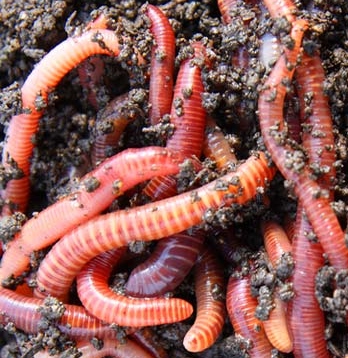Red worms: A guide to their life cycle
Rise Soil Health And Wellness Naturally With Red Wigglers
The combination of red wigglers into dirt monitoring practices provides a compelling technique for boosting soil wellness naturally. These earthworms not just change organic waste into beneficial vermicompost, but their all-natural behaviors likewise promote improved soil structure, aeration, and nutrition accessibility. Nevertheless, recognizing the intricacies of establishing and maintaining an effective vermicomposting system is crucial to fully leverage their benefits. Checking out the important actions and prospective difficulties entailed can significantly affect the efficiency of this lasting method. What vital elements should be thought about to maximize the advantages of these remarkable decomposers?
Benefits of Red Wigglers

Furthermore, red wigglers boost soil framework by developing networks as they burrow via the earth. This activity enhances oygenation and drain, facilitating root development and guaranteeing that plants receive sufficient oxygen and wetness. Furthermore, the spreadings created by red wigglers are high in nutrients such as nitrogen, phosphorus, and potassium, which are crucial for plant development.
Red wigglers likewise aid in the reduction of damaging virus and parasites by outcompeting them for resources, additionally adding to a healthier soil environment. Their existence can result in a decline in the need for synthetic plant foods and chemicals, advertising lasting agricultural practices. Overall, incorporating red wigglers into soil administration strategies gives a natural and reliable means of enhancing soil vigor, consequently supporting durable plant development and farming performance.
Establishing Vermicomposting
Developing a vermicomposting system is a functional way to harness the amazing advantages of red wigglers in enhancing soil wellness. red wigglers. To start, pick a suitable container-- preferably, a plastic or wood bin with a cover to keep dampness and temperature level. The container ought to have water drainage holes to avoid excess water accumulation
Next, prepare bed linens product, which works as a habitat for the worms. Appropriate products include shredded paper, cardboard, or coconut coir. Purpose for a depth of 4-6 inches to provide sufficient room for the worms.
Once the bedding remains in place, present the red wigglers, normally at a ratio of one extra pound of worms for every square foot of area in the bin. Following this, include cooking area scraps such as fruit and vegetable peels, coffee grounds, and crushed eggshells. Stay clear of meat, milk, and oily foods, as these can bring in bugs.
(red wigglers for composting)
Taking Care Of Your Worms
Maintaining the health of your red wigglers is crucial for a flourishing vermicomposting system. Appropriate treatment makes sure that these helpful microorganisms can properly break down raw material and enhance your dirt. Begin by providing a suitable habitat; a well-ventilated bin with a damp, dark environment is important. Go for a bed linen product that consists of shredded paper, cardboard, or coconut coir, which need to be maintained moist however not filled.
Feeding your worms is one more crucial aspect of their care. Red wigglers grow on kitchen scraps such as fruit and veggie peels, coffee premises, and smashed eggshells.
Temperature administration is essential; worms like an array of 55 to 77 degrees Fahrenheit. By adhering to these guidelines, you will certainly cultivate a healthy environment for your red wigglers.
Making Use Of Worm Castings in Soil
Worm spreadings, often referred to as "black gold," are a powerful amendment that can significantly enhance dirt health and wellness and fertility. red wigglers. These nutrient-rich, organic plant foods are produced by red wigglers during their digestion procedure, resulting in a finely textured product that is advantageous for plants and dirt alike
Incorporating worm spreadings into your dirt boosts its structure, enhancing oygenation and water retention. This is especially advantageous for sandy dirts that drain pipes as well promptly, as well as hefty clay soils that can become compacted. Worm spreadings are packed with vital nutrients, consisting of nitrogen, phosphorus, and potassium, which are essential for plant development.

Inevitably, the use of worm castings cultivates a successful ecological community within the soil, resulting in much healthier plants and more sustainable gardening methods.
Tips for Successful Composting
Effective composting calls for careful interest to a few essential concepts that can significantly improve the top quality of the end product. First, balance is vital; preserve a proper proportion of green products (nitrogen-rich) to brown products (carbon-rich), preferably around 1:3. This balance promotes reliable decay and decreases odors.
2nd, oygenation plays a crucial role. On a regular basis turning the garden compost pile improves oxygen circulation, which accelerates microbial task and accelerate the composting procedure. Go for a stack dimension of at the very least three feet by 3 feet to preserve warm, which better promotes disintegration.
(redworms for composting)
Moisture web content is another crucial factor; the garden compost ought to be damp however not soggy. A good guideline is to achieve a wetness level comparable to that of a wrung-out sponge. As well much water can bring about anaerobic conditions, while also little can decrease decomposition.
Last but not least, check the temperature level of the garden compost. A temperature level variety of 130 ° F to 160 ° F suggests energetic composting and helps eliminate microorganisms and weed seeds. By sticking to these principles, you will develop a nutrient-rich garden compost that sustains dirt health and wellness and improves plant growth.
Final Thought
Including red wigglers into gardening methods enhances dirt health with natural processes. These worms add to the malfunction of organic materials, resulting in nutrient-rich vermicompost that improves soil framework and fertility.